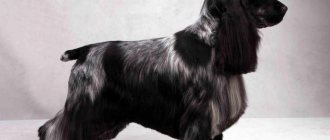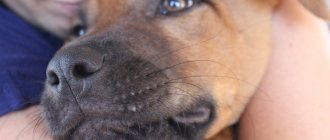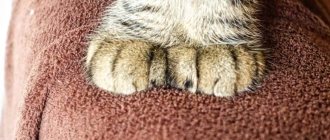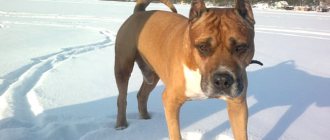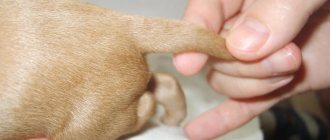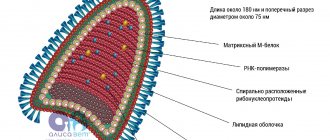Ear cropping helps prevent injuries to dogs: if a dog has short ears, then he is less vulnerable in a fight with an enemy. From century to century, guard and fighting breeds have been subjected to this procedure, but today it serves more of an aesthetic purpose. A beautiful head shape is formed according to standards. After cropping, the ears always stand up, so the dog has a serious, menacing appearance. There are also medical reasons for the operation - some breeds simply need docking.
Post-procedure care
Caring for a Central Asian Shepherd after surgery will not be difficult.
Usually babies are taken away from their mother, as the female licks the crumbs and thereby does not allow the wound to heal. They are fed 6 times a day. A bandage is usually not applied.
The little Alabai is placed on a clean bedding that needs to be changed every day. The wound is treated within 10–14 days, even if it appears to be completely healed. After which the stitches are removed.
Possible complications
If the shortening of the ears and tail was carried out incorrectly, the following complications may occur:
- Heavy bleeding.
- Tissue necrosis.
- Inflammation and infection of the wound.
- Loss of coordination due to shortening of the tail.
- Seals and scars.
The first three cases require treatment by a veterinarian; scarring, as a rule, does not occur in puppies under 14 days old.
Central asian shepherd dog
This is an ancient working breed with deep traditions. Dogs have a peculiar shape of ears, which are trimmed in the first days of a puppy's life. Then you don’t have to put stitches, and the wounds heal quickly.
The Central Asian Shepherd used to herd herds and fight predators. Her ears are her weak spot. When wounded, an adult Alabai loses a lot of blood, so shepherds always shortened the ears of puppies.
According to the standard, half of the cartilage remains, and the cut is semicircular or straight. “Caucasian” is the shortest form, “bear” is very popular, with it puppies look like funny bear cubs.
Operation technique
The cupping operation is classified as planned. Before surgery, you need to make sure that the puppy is healthy. In addition, 12 hours before the start of surgery, the puppy is stopped feeding, and the animal is not denied water.
The veterinarian explains to the owner the essence of the operation and the risks that arise. The owner of the dog gives written consent to the operation and confirms with his signature his understanding of the dangers of surgical intervention.
The premises, instruments and clothing of personnel must comply with aseptic and antiseptic regulations. The sterility of all objects and materials involved in the operation is a condition for the absence of postoperative complications. Therefore, despite the availability of proposals for performing cupping at home, it is better to carry it out in a clinic.
It all starts with treating the surgical field, that is, the ears, with alcohol or another antiseptic. Taking into account the fact that the site of exposure is not shaved, antiseptic treatment is carried out especially carefully. Next, the dog is placed on the table. Its jaws, body and limbs are fixed. The ear canal is protected with a tampon.
If in past centuries ears were trimmed without anesthesia, now neuroleptics are used in combination with local anesthesia. Haloperidol, rompun or their analogues are used as antipsychotics. For local anesthesia, traditional novocaine or lidocaine are used regularly.
When removing an unnecessary part of the ear, the surgeon relies on his experience or uses a pattern for cropping ears in dogs. The second method can be considered more reliable. Moreover, there are stencils for all breeds, all ages and all characteristics of a dog’s muzzle: short, normal, elongated.
After ear trimming, stitches are applied. Silk thread is most often used as a ligature. To avoid hematomas, damaged vessels are secured with a suture. The second ear is shortened in the same way. The ends of the threads of the uppermost seam on both ears are tied. Apply a bandage. The operation ends with the removal of the fixing bandages.
In the photo there are patterns for cropping dogs' ears
How to place the ears?
Some breeders believe that after cropping the ears stand up on their own - this is a common misconception. In order for the ears to stand up correctly, they must be glued, following the recommendations of the breeder or supervising veterinarian.
A common reason that the ears do not stand up is creases, so before gluing you need to make sure that they really are there . To determine them, you need to squeeze the base of the auricle and palpate the entire surface as carefully as possible, slowly moving from the base upward.
If during the examination you find a small strip of tissue, it should be clamped on both sides; if at this moment the ear takes a vertical position, the cause of the problem has been found.
The mechanism for correcting the situation depends on the location of the problem area. If the upper area is affected, then the situation will be corrected by taking special vitamins; if the scar tissue is located at the base or in the middle of the auricle, you need gluing. It is usually carried out using massive structures. It is advisable to carry out all manipulations under the supervision of an experienced veterinarian , since if the frame is installed incorrectly, at best you risk getting a setup that does not meet breed standards, and at worst - poor circulation of the pet.
In recent years, a special adhesive-fixer has become very popular, which, during the drying process, holds the ear in the chosen position, without requiring the use of additional materials.
What breeds of dogs need docking
What breeds have their ears cropped? Ear cropping is standard for breeds such as Great Danes, Boxers, Rottweilers, Schnauzers, Dobermans, and American Terriers. Caucasian Shepherds and Central Asians are usually separated from this group: they usually carry out the docking procedure much earlier - at the age of a week. There is a whole system for choosing the correct ear shape - it depends on the ratio of body proportions, but in general, the most comfortable format for all breeds is simply adopted. In principle, the owner has the right to choose the shape of cropped ears, since such features do not play a role in the exhibition process.
Ear cropping in Caucasians is a complex procedure, the peculiarities of which are not only the early execution time, but also the need for certain knowledge from the surgeon: in addition to understanding the process, the veterinarian must focus on the characteristics of the auricle of the parents
At the same time, it is important to take into account the wishes of the breeder
Tail docking in dogs. The following breeds are subject to tail docking: English and American Cocker Spaniels, Boxer, Doberman, Airedale Terrier, Bobtail, Giant Schnauzer, Yorkshire Terrier and others. In some cases, half or a third of the tail is left; usually the length is calculated based on the vertebrae: 2 or 5 vertebrae are left.
Many veterinarians and breeders insist on the need for this procedure, threatening dogs with natural ears with painful ear infections. But long-term observations confirm that ear diseases in dogs (for example, otitis media) appear equally often in boxers with cropped ears and in long-eared spaniels.
- How to determine what kind of dog to have in an apartment? The best and worst breeds for keeping at home.
- To keep the house clean, your pet must be trained to use the dog toilet. How to do it?
- Do you want to knit an outfit for your dog with your own hands? We'll tell you what you need for this.
Types of cupping
The type of ear cropping largely depends on the type of dog and the characteristics of its appearance . For example, in Caucasian Shepherd dogs, the entire ears are usually removed; in breeds such as the Staffordshire Terrier and Pit Bull, only 2⁄3 are cut off; in Doberman Pinschers and Great Danes, even after circumcision, fairly large ears remain.
The edges can also be cut in different ways - usually the cut is made straight or S-shaped.
Tails are supposed to be docked at certain vertebrae. But the fact is that at such an early age, when puppies are only a few days old, it is quite difficult to palpate the vertebrae, so trimming the tail is carried out exclusively in accordance with the wishes of the dog’s owner.
Docked tail: technology features
Tail docking - methods.
- tight elastic method - consists of tightening the tail with a tight loop at a certain level (the skin needs to be pulled back to the beginning - but in some breeds this is not so easy);
- circumcision method - performed with special scissors (the procedure is extremely simple: the tail is clamped, cut off and treated with an antiseptic).
The differences in the methods are visible and understandable - the first of them is completely bloodless, which makes any blood poisoning impossible: the tail simply stops being supplied with blood and dries out. According to the observations of specialists and breeders, a puppy has no problems with a drying tail - he simply does not notice it.
The second method is much more dangerous: there is a possibility of infection of the open wound. If the surgeon decides to sew up a wound on the tail, then it is necessary to use anesthesia to avoid shock in the puppy
With this method of relief, proper care of the wound after surgery is important: despite the fact that the wound heals quite quickly, it is important not to tear off the resulting crust and not cause an infection
A little history
In the 18th century, residents of England had to pay a dog tax on every four-legged representative, unless he was a service dog, for which tail docking was a mandatory procedure.
The reason for removing the tail of many dogs in those days was to allow hunting dog owners to evade responsibility for poaching. Hunting dogs did not have their tails docked. Shepherds of sheep flocks were exempt from paying the tax. They docked the tails of their assistance dogs to reduce their injury in fights with predatory animals. Therefore, many residents of Foggy Albion, in order to avoid taxes, cut off the tails of their pets, showing that the dog was a representative of the service. Over time, laws changed, the tax was abolished, but bobtail remained a necessary attribute of some breeds.
Cupping provided by the standard
Pros and cons
First, let us present the arguments that support docking.
- Sanitary and hygienic condition of the animal. According to some veterinarians, as well as amateurs, the ears after the procedure are less susceptible to otitis, inflammation and the influence of foreign objects. Cropped ears are less likely to suffer from ticks, mosquitoes and other parasites. Due to the openness of the ear canal and the absence of the main part of the auricle, the dog is much less likely to develop infectious diseases.
- Aesthetics. Dogs, whose main task is to protect their owner and his property, should always look menacing, and docking has long been considered a sign of powerful and aggressive dogs.
- Functionality. In former times, ears were always cropped, and although nowadays we are no longer talking about collisions with predatory animals and participation in dog fights, nevertheless, in a fight with other dogs or a person, the enemy can always injure the pet if the defender grabs the ears.
But there are arguments against cupping.
- Any circumcision of ears and tail is, first of all, a surgical intervention and, as a consequence, the suffering of the animal, the deterioration of its mental state under the influence of anesthesia, pain and the operation itself.
- Many veterinarians argue that the sanitary and hygienic importance of the procedure is seriously exaggerated, and the arguments presented have no basis.
- Breeders with extensive experience believe that the aesthetics of cropped ears and tails is a rather controversial and untenable issue.
- Scientists around the world have come to a consensus that docking causes significant harm to some animals, since both ears and tails, along with facial expressions, are considered one of the means of communication of dogs. In addition, the tail is one of the main tools for controlling the movement of dogs.
- A pet with cropped ears cannot be entered into competitions in European countries where the procedure is prohibited.
Caucasian Shepherd Dog
This breed was created for protection. The operation is performed to protect the dog from infection if the animal is injured. Ear cropping is also necessary to create the dog’s characteristic appearance.
From the age of 3 months, puppies fight for territory and leadership. By six months, only rags remain from the auricle. When the puppy is strong enough, he is docked. There are no uniform patterns, because each animal has an individual head shape and ear structure. As a rule, the top part is cut off.
Description and features of cupping
Cupping is an operation that is cosmetic in nature. It is performed on puppies of some dog breeds. It affects Great Danes and Dobermans, all schnauzers, many guard and herding dogs, pit bulls and other fighters. In this case, functional and aesthetic goals are pursued.
During resection, the ears are shortened to varying lengths. Caucasians and similar breeds lose their ears almost completely. Staffordshire Terriers are luckier; they are left with a third of the ear. Great Danes and Dobermans have a small portion of their shell amputated. In addition, the specialist performing the operation must take care not only of the length, but also of the future shape of the ear.
The reduction operation affects the hearing organ, which consists of 3 components: external, middle and internal. The easiest part is the outer ear. It, in turn, includes: the external auditory canal, the motor system of the ear and the auricle. All of them are linked into a single sound wave concentrator.
The auricle is cartilage with varying degrees of elasticity. It is covered with hairy skin. Between the skin and cartilage are the muscles of the auricle. The base of the concha is hidden and rests on a fatty layer that provides mobility to the ear. The protruding part is called the rook.
The outer part of the boat is the back of the shell, the inner part is the navicular fossa. It directs sound into the ear canal. The scalpel affects only the cartilage and skin tissues from which the scapula is formed, that is, the protruding part of the auricle.
Cupping is a proven operation, but, like any surgical intervention, it has some risks. Most often, relief is carried out with local anesthesia with the participation of an antipsychotic. Anesthesia poses some risks. The techniques and pharmaceuticals of local and general anesthesia have long been known, but the reaction of the puppy’s body is not always predictable.
Complications are unlikely but possible after surgery. The seams may become inflamed and infectious processes may begin. Some puppies' bodies may not respond adequately to medications the dog receives before, during, and after docking. The likelihood of unwanted manifestations is small, but it exists. Veterinarians have long learned to deal with them.
Why do you dock a dog's tail?
The tail is a full-fledged organ and serves as a balancer and assistant when dogs communicate. In a working dog (herding, hunting, guard) he is at risk of injury during his service:
- has a vulnerable spot in a fight with a predator ;
- Stab and cut injuries to the tail of a hunting dog when moving on rough terrain;
- The shortened tail of a guard dog makes the animal more invulnerable and maneuverable .
The rest of the dogs have their tails trimmed to maintain the traditional appearance of the breed. Some breeds have a complete, familiar appearance if both their ears and tail are docked.
In some cases, cupping is performed for medical reasons.
Cat declawing or soft paw surgery
The soft paw operation has become widespread among cat breeders. Unfortunately, not all cats have a calm character. They often express aggression, especially during sexual heat, and scratch people. It is scary if a cat shows aggression towards children, and even the most patient cat can instinctively hurt a small child, responding to his obsessive interest in himself. All this can lead to unpleasant injuries to a person, especially eye injuries.
There are cases of people falling ill with “cat scratch disease”, the wounds take a long time to heal, become inflamed, the lymph nodes also become enlarged, the temperature may rise, and a complex course of antibiotics is prescribed. If, in addition to the cat, there are small dogs in the room, then they also often suffer from cat claws. A cat, defending itself, can injure the dog’s eyes, and keratitis and conjunctivitis develop. Not to mention the fact that many owners feel sorry for wallpaper, expensive furniture, and doors torn off by a cat.
In such cases, cat owners resort to surgery to remove the claw plate, which is called “soft paw.” The operation is classified as cosmetic; it is performed under anesthesia; two stitches are placed on each finger. For the first 3 days, the sutures are treated with iodine, and after 14 days they are removed. The removed claw no longer grows. The procedure can be combined with castration or sterilization of the cat.
Cats usually tolerate this operation well and subsequently do not experience any discomfort from the lack of claws. This does not in any way affect the animal's gait or lifestyle. Owners must also accept additional responsibility and understand that such an animal can no longer be released unattended into the yard or from the territory of their summer cottage, as it cannot fend for itself.
Who cares about the tail?
Hunting dog breeds with docked tails are also supposedly protected from frequent injury. In a hole, the tail can be broken; in a pack, male dogs often fight; prey that does not want to die can pull the dog by the tail or ear. But why isn’t the tail of a northern dachshund docked, but a normal fox terrier’s tail must be cut off? It's simple: the tail of a dachshund favorably emphasizes its features - long, straight, continues the line of the back, while the tail of a compact terrier does not fit into the desired format. Or Caucasian and Central Asian shepherd dogs - guards, defenders, enemies of wolves and two-legged intruders, similar in type, character, and even history of origin. But some with luxurious tails, and others with stumps.
In the 1990s, canine organizations in Europe decided to abandon docking as a useless and inhumane cosmetic operation. Everyone understood perfectly well why dogs have their tails docked, even when the puppies will clearly become pets, and not guards or hunters. This is beneficial, because it is very difficult to get beautiful tails from offspring, especially when breeders have ignored this part of the dog’s body for decades. Through selection, the head shape, general format, paw placement and character were brought to the ideal, but not the tail, which had to be cut anyway. And there are also creases that put an end to a puppy’s career and significantly reduce its value. And if there is no tail, there are no problems.
In Russia, this ban does not apply, however, serious breeders have stopped docking the tails of dogs, since cutting off the tail is tantamount to a refusal of world recognition. Getting an ideal puppy of your own breeding from a kennel, and not having the opportunity to demonstrate the fruit of your labor in the homeland of cynology, is not just a blow to pride. This is pointless, because the breeder’s goal is to improve the breed and popularize it. And this is out of the question if the tail is cut off. In Europe it is prohibited to show such dogs, even if they were born in a country where docking is still practiced.
What is ear cropping and why is it needed?
Cupping is an operation that involves shortening the ear; in some cases the shell is removed almost completely, in others it is left long. It depends on the historically established standard and fashion for various forms.
The procedure has a long history, dating back to the times of Ancient Egypt and Rome. Dogs with cropped ears are found in images of coin impressions, frescoes, and wall paintings. The ears were cut off mainly for hunting and fighting dogs (Molossoids, Pinschers, Schnauzers and other breeds).
It was believed that such cosmetic intervention makes the dog more formidable in appearance. From a medical point of view, this cruelty is justified by the fact that a pet with cropped ears is more difficult to wound in battle. The Romans were sure that the operation was a prevention of rabies. In addition, the dog in the forest did not catch its ears, did not pick up ticks and other dangerous insects. Cropped ears are better ventilated, which prevents the stagnation of cerumen fluid and the occurrence of inflammation.
Likewise, over the centuries, standards have evolved to require cropped ears on certain breeds. Pets that do not comply with the rules were not allowed to participate in exhibitions. This developed the trend of fashion in the direction of operations for animals, which made docking a real mockery. Since the end of the 20th century, many European countries have prohibited such a measure unless it is part of treatment. This law has not yet been developed in Russia.
Now the standards have softened their conditions; pets with ears of normal length are increasingly allowed to participate in exhibitions. Dogs that no longer serve, but are purely companions, really have little need for such a procedure. Therefore, only the owner can make the decision regarding docking.
What age is suitable for ear cropping?
In any case, the operation must be performed within 6 months, but the owner has a choice. There are three options for performing the operation, each of them has its own advantages and disadvantages.
Cupping of puppies up to 2 weeks old. During this period, the dog is least sensitive to physical impact, easily tolerates pain and is unlikely to remember it. In addition, tissue restoration and healing occurs much faster than in adult dogs, because the puppy is in contact with the mother and feeds on milk. But due to the incomplete formation of blood vessels, the wounds can bleed for a long time, and it is also difficult to predict the dog’s appearance, so cropped ears may look disproportionate when the pet grows up.
7-13 weeks of life. During this period, the puppy is not yet very susceptible to pain, but the cartilage tissue is soft, and regeneration occurs quickly. No scars remain at the site of the wounds.
3-6 months. The procedure is delayed due to any illness or congenital health problem. The specificity of the operation in adulthood is that the dog will need full anesthesia and suturing of the wound to avoid the appearance of dense, rough scars
It is important to ensure that your pet does not experience complications.
In veterinary medicine, it is customary to perform surgery between 14 days and 13 weeks of age. The time for cupping is selected based on individual characteristics. For example, small dogs undergo the procedure earlier than large ones. The shape of the ears also influences; complex shells are stopped at an older age.
What breeds is the procedure recommended for?
The procedure is useful for service dogs with long ears from birth. Historically, it has been customary to trim the ears of Great Danes, Dobermans, Schnauzers, Rottweilers, Boxers, Cane Corsos, Bull Terriers, Caucasian and Central Asian Shepherds.
Nowadays, countries rarely put forward specific conditions regarding operations to improve the exterior, so only the owner can decide whether this manipulation is necessary.
Preparing the dog
A few days before the procedure, the puppy is shown to the veterinarian to ensure that the pet is 100% healthy. The specialist will be able to determine whether the operation is permissible for a particular individual, and whether the dog has congenital abnormalities.
- The pet is prohibited from eating 12 hours before docking, although the drinking regime should not change.
- The veterinarian will give an anesthetic injection. For adult dogs - general, and for small dogs - local.
- The ears are shaved and treated with antiseptic solutions.
- The dog is fixed on the surgical table so that it lies on its side with its hind and front legs extended.
- For older animals, the jaw is secured.
It is important to calm your pet and be with him during the process. Now there is a service where a specialist comes home
The puppy’s psyche is not traumatized by moving and changing surroundings. He will feel calm and relaxed. You cannot offend or scold a child.
Veterinarian advice
In order to avoid the adverse effects of docking, the dog requires quality care.
In particular, to prevent your pet from damaging its own stitches, you should use a special device - an Elizabethan collar, it is made of conical plastic. If the animal is suffering too much, it is allowed to give it a mild pain reliever.
It is very important to monitor the condition of the seams - they must be kept clean and sterile. Typically used for processing:
- brilliant green;
- tincture of calendula or chamomile;
- iodoform, streptocide, xeroform and other antiseptic powders.
Treatment must be carried out every day; in some cases, the doctor may recommend the use of liniments - if healing is too slow or with complications.
Postoperative sutures are removed on days 7-14.
After recovery, it is necessary to constantly strengthen the ear cartilage; for this, pets undergo regular massage.
The first time after surgery, dogs may feel confusion, pain and even shock. During this difficult period, it is important to take care of the psychological state of your pet - support it, distract it and show your love and care in every possible way.
The healing process must be kept under constant control - if you notice any undesirable changes, or you have suspicions that healing is not going as it should, contact your doctor immediately.
For information on ear cropping in dogs, watch the following video.
Everyone has long been accustomed to seeing dogs of certain breeds in a certain form. For example, without a tail or with a specific ear shape. Usually Rottweilers, bulldogs, Dobermans, terriers, Great Danes and a number of other breeds are docked. But is it necessary to do this, and how does it affect the general condition of the dog?
Docking is a cosmetic surgical procedure that involves removing parts of the ears or tail of some pets. This is not a sacrifice to the bloodthirsty dog god, as it might seem at first glance, not a final exam in a circle of flayers, but the requirements of the standard of certain dog breeds. Cats also occasionally have their ears docked, and their tails less often.
The decision on the need for this medical procedure is usually made by the owner himself. Glorypets sheds light on all the nuances of docking, and at the forefront is the question of its appropriateness.
Ear and tail docking for dogs
Surgical removal of part of the ear or tail is standard for some dog breeds. For example, it is customary for puppies of Doberman, Great Dane, Pitbull, American Staffordshire Terrier, Caucasian Shepherd, various kinds of “schnauzers” and some other breeds to have their ears cropped at the age of 2 to 4 months (although some breeders of purebred animals prefer to do this to babies as young as two years old). weeks old). Tails are cut off in accordance with the standards for Rottweilers, toy terriers, Yorkshire terriers, Dobermans, and boxers. Tail docking is an extremely painful procedure; they try to perform it on puppies at the age of 3-10 days, when their tails are still cartilaginous.
The ears are cropped under anesthesia, the operation itself lasts about 40 minutes, the edges are cut off according to patterns and sutured. Subsequently, the dog's owner will have to treat the stitches daily for two weeks to prevent them from festering. On day 14, if healing occurs as planned, the sutures are removed. This manipulation is carried out with only one purpose - to bring the animal’s ears to a “standing” position, as required by the ancient, often dense and harsh standard.
Puppies are deprived of their tails for the same purpose: the standards say that it is more beautiful, and most importantly, safer for dogs of fighting breeds, which a century ago in bloody battles brought their gambling and somewhat unscrupulous owners good money. The operation is performed under anesthesia if the pet has reached seven days of age and its body is able to withstand it. Younger dogs have their tails docked, as they say, “on the spot.” If your pet is not de-tailed in time, this can still be done before he turns 8 months old, but the intervention will be more global: under general anesthesia, with sutures.
Should I crop my dog's ears or tail?
This question is asked by all owners without exception who are not indifferent to the feelings of their pets. Are breed standard requirements so important? What, in essence, do they give, besides making the dog look the way it supposedly should? And what do animal rights organizations, veterinarians and the world community think about this?
Proponents of cropping often argue in favor that ear cropping prevents the development of ear infections and injuries. But veterinarians categorically reject this argument: according to doctors, representatives of different breeds suffer from infections, regardless of whether their ears are intact or not. Speaking of injuries, torn ears and broken tails are a thing of the past with the ban on dog fighting.
Opinions of opponents of “truncation” are based on the fact that during the operation the animal’s psyche is undermined and this leaves an imprint on its entire future fate and behavior. Despite the fact that there is no direct scientific evidence for this, one can intuitively guess that such procedures and recovery after them cause physical suffering to animals, and this entails psychological discomfort.
Every year there are more and more exhibitions in the world where dogs with docking are not allowed. In most countries of Western Europe, as well as in Australia, this inhumane procedure is prohibited at the legislative level, thanks to the active work of animal protection organizations. In 1992, member states of the Council of Europe adopted the Convention for the Protection of Pet Animals, according to which docking was outlawed. Exhibitors and owners in Eastern Europe, many CIS countries and the USA may have yet to arrive at this point. The Convention can come into force in any country, regardless of whether it is part of the European Union - it just needs to be adopted at the state level. However, despite the fact that docking is still allowed in many countries, many cynological organizations follow the path of “humanization” of breed standards and make adjustments to the requirements for breeds that are in the “risk zone”, according to which they are allowed to participate in exhibitions. both docked dogs and unharmed ones.
In Russia, docking is officially permitted, but not mandatory. The decision, as usual, remains with the owners. We hope that your choice will be correct.
When to crop ears
Most often, owners of Alabais, Rottweilers, some varieties of Pinschers, Staffords, and Boxers undergo this procedure. For example, if you crop a Doberman's ears, the dog takes on a truly hunting look and a warlike appearance. Ears are also shortened to reduce the risk of injury to dogs participating in fighting matches.
But in addition to aesthetic considerations - for example, compliance with exterior standards (relevant for nurseries and exhibitions), there are a number of indications for which the procedure is necessary:
- neoplasms having the nature of tumors;
- necrosis of one or both ears;
- various injuries;
- ulcers on the inside or outside of the ear;
- Some types of dogs are susceptible to otitis media, so docking is a must for them.
It is important to know that ear cropping in puppies should not be carried out from birth - in babies aged about a month or earlier, it is difficult to correctly assess the shape and size that will be characteristic of the auricle as the individual grows up. The optimal age for surgery is from 6-7 weeks to one year
Also, do not forget that the older the dog, the denser its cartilage and the more complications can arise even after such a minor surgical intervention.
Ear cropping is contraindicated for any deviation in the animal’s health:
- severe lethargy;
- discharge from the ears;
- decreased/increased appetite;
- swelling of any part of the body.
If these signs occur, you should postpone operations and immediately consult a veterinarian.
Doberman Pinscher
Many people consider the Pinscher to be cruel and aggressive. But this is a beautiful and noble breed, practically no different from the Doberman. According to owners, ear cropping gives the dog a special charm. Vulnerability in combat is not so relevant today. The operation pursues decorative and hygienic purposes. The dog becomes better protected from wounds, necrosis and neoplasms.
The procedure is carried out 3-10 days after the puppy is born. 3/5 of the original length remains. An adult Doberman Pinscher's ears point straight up and forward.
Complications of the operation
- Bleeding. You can stop it by cauterizing it with potassium permanganate crystals, iodine, or brilliant green. Apply a tight bandage.
- Darkening of the tip. It may indicate the onset of gangrene and tissue death. It is better to take the dog to the clinic immediately. The danger is great, gangrene indicates the onset of severe inflammation, pathogens are easily spread throughout the body, and death is possible.
- The method of pulling a tourniquet can have a detrimental effect on health - necrotic tissues will imperceptibly creep onto clean ones, causing the death of the entire tail.
- Severe hyperemia of the area, development of pustules, appearance of ulcers. The phenomenon is rare, but still occurs when an infection occurs due to the use of unsterile instruments. Requires urgent veterinary intervention.
The process of trimming a puppy's tail at home
Tail trimming is carried out before the age of 10 days. The most painless option is 2-5 days. At this age, the bones have a cartilaginous shape, and the nervous system is at the stage of formation.
Cupping is carried out at home. The operation is ordered from a veterinarian or the breeder performs it independently. Circumcision is carried out in two ways.
Squeezing
To do this, the tail is pulled with an elastic band, leaving the desired length. After some time, the part of the tail left without blood flow dies and is removed.
The disadvantage of this method is the inaccuracy of the result. The length of the remainder may be slightly shorter or longer than required. For a large dog with medium-length hair, this is not important. In dogs with short hair, the length of the tail becomes noticeable.
Surgical method
The skin of the tail is pulled towards the tip and cut with surgical scissors to the required length. The tip is treated with an antiseptic. Puppies under 5 days of age do not require sutures for docking.
To avoid infection, puppies' bedding is kept clean.
How to shape ears
It is necessary to prepare your pet for surgery in advance. You need to get all the necessary vaccinations and deworming. The pet must be healthy.
The dog stops feeding 9-10 hours before surgery. Before visiting the veterinary clinic, be sure to take it for a walk.
The operation is performed under general anesthesia, although local anesthesia is also acceptable. During surgery, it is not enough to simply hold the docked puppy.
It is important that he does not move his head, is not aggressive and does not whine
Stages of the operation:
- anesthesia is administered;
- the fur is shaved off;
- indicate the exact location where the incision will be made;
- in some cases, a special pattern is used. It is easy to draw an accurate line along it, and the clamps clamp the blood vessels and prevent blood loss;
- the skin must be moved towards the head so that its edge subsequently covers the incision site;
- the incision is made with a scalpel;
- in large breed puppies with thick ears, the surgical site is cauterized;
- The edges of the skin are sewn together with special threads or glued with medical glue.
In some cases, painkillers are given after surgery.
Caring for your ears before removing the stitches involves treating the wound with an antiseptic. If the crusts begin to peel off, then soak them and remove them. To prevent the pet from combing its ears, a special collar similar to a funnel is placed around its neck.
If a docking procedure is necessary for your pet, it is advisable to do it as soon as possible and provide proper care after the operation.
https://youtube.com/watch?v=vZwwlbpQcOs
How does the procedure work?
Tail docking technique:
- Before surgery, the animal is kept on a fasting diet for 12 hours, while the temperature is measured hourly. Normal body temperature for a dog is 37-39.5 degrees.
- 2 weeks before the procedure, the dog must be dewormed (cleansing the body of worms).
- Before the operation, the amputation site is trimmed and shaved, and the fur is removed at a distance of at least 2 cm on each side. This area is then disinfected.
- If the puppy is older than 3 weeks, then a tourniquet is applied to the base of the tail, and local or general anesthesia is also used.
- If the dog is more than a month old, then it must be fixed on the operating table.
- During the operation, two fingers are used to pull the skin of the tail at the base, gathering it into a fold. Then, using a scalpel, part of the tail is cut off in the right place.
- After amputation, the skin is released and it completely covers the wound, which prevents infections and promotes speedy healing.
Stages of ear cropping in Alabai:
- The dog is kept on a starvation diet for 12 hours before surgery.
- Administration of antipsychotic and local anesthesia.
- Closing the ear canal with a cotton swab to prevent blood from flowing into the ear.
- After the shape of the ear is chosen, a special flare (pattern) is applied to the auricle. To do this, the skin of the auricle is shifted as much as possible towards the base so that the shape of the stump is correct. When applied, the lower end of the flange should be closer to the auricle, and the upper end should be on the border of the upper and middle thirds.
- When everything is ready, the auricle is cut off using a sharp scalpel, while the cut off part serves as a template for the second ear.
- Cupping of the second ear.
- Just below the flap, an intestinal clamp is placed on the auricle to prevent bleeding, and after 10 minutes the flab is removed.
- Stitching. In this case, the skin is pierced first from the inside of the auricle, and then from the outside. For sewing, use catgut or thin silk threads.
- At the end of the procedure, the ears are placed on a gauze pad at the back of the head and bandaged.
- The bandage is removed on days 3-4, and the stitches on days 7-14 after surgery.
Preventive measures during cupping
The technique for performing tail and ear docking surgery is the same for all dogs. The only difference is in the standards of the cupping itself.
It is always necessary to take into account all possible risk factors, both when performing surgery on a puppy at the age of 2 days, and when performing this operation on an adult dog. To do this, it is necessary to collect a life history of the puppy and its parents: find out from the owners or breeder how the birth went, how the puppies developed, whether there were any complications, what diseases the puppy’s parents have, and what hereditary diseases the puppy may have.
Some dog breeds should have their hearts checked because they are at risk for hereditary diseases, such as Doberman Pinschers.
There must always be the right choice of drugs and consumables for this operation.
It is always necessary to prevent the possibility of wound infection by using antibiotic therapy.
Cost, where can cupping be done
In all EU countries, docking is strictly prohibited. Operations here are carried out only illegally at home. In Russia, docking can be done both at home and in specialized veterinary hospitals. Due to the complexity of the operations and the difficult rehabilitation period, veterinarians do not recommend performing operations at home, as this can lead to serious complications for the dog.
The cost of the procedure for the ears is 500 rubles, cutting off the tail will cost from 2,000 to 4,000 rubles.*
Peculiarities of docking in different breeds of dogs
For each breed in need of surgery, there is its own set of forms allowed by the standard. In addition, the operation may vary depending on the size of the dog and its physical characteristics.
Ear cropping of Staffordshire Terrier (Amstaff)
The Staffordshire Terrier standard specifies cropped ears, unlike the Staffbull. Which is considered strange, because the breeds are close. It is this fact that explains that, most likely, surgery for these dogs is not necessary, but is considered purely cosmetic. Owners are still confident that short ears look aesthetically pleasing and make the dog look more respectable. Since Staffs no longer participate in dog fighting, there is no point in carrying out the procedure.
The operation is performed at 1.5-3 months under general anesthesia. There are several options for the correct shape of cropped ears for this particular breed: fighting (the shortest), short, show and long. For Staffs, it is not necessary to apply forming bandages; often the ears themselves take the desired position.
How are the Miniature Pinscher's ears cropped?
The miniature pinscher is now a decorative breed, which does not interfere with long ears at all. Therefore, the operation is only cosmetic in nature. It is carried out at 3 months. Due to physiological characteristics, the ears need to be fixed. This is usually done by a veterinarian using band-aids and cotton swabs.
Ear cropping Alabai
For Alabai, the procedure should be carried out as early as possible to avoid blood loss. Cupping is often carried out directly during childbirth. If this is not possible, then the ears are cut off before 3 days of age. For this breed, the short form is considered the only correct option. But it is also divided into several types:
- Standard (medium length with a semicircular or straight cut);
- Mishka (elongated cartilage with a semicircular cut);
- Caucasian (1.3 cartilage is the longest acceptable option).
Doberman
For this breed, the procedure is carried out within a period of 3 days – 8 weeks. It is not recommended to have surgery while changing teeth. A characteristic feature of the operation for Dobermans is that the animals are left with very long cartilages, only 2/5 of the ear is cut off
After this, it is important to place the shells correctly, for which bandages and clamps are used
Shepherd dogs
For Caucasian Shepherds, like Alabais, the procedure is carried out immediately after birth for 8-20 hours. It is recommended to postpone surgery no longer than 7 days. After this, the ear tissue will harden, so cupping may lead to complications. If it was not possible to trim the cartilage at an early age, then this can only be done at six months under general anesthesia.
Cane Corso
The breed's ears are now cropped only for strict conformation. It is believed that dogs with long shells look awkward and funny. The correct shape is a rounded short triangle laid back. During the formation period, bandages will not be needed, but the position must be fixed with a plaster.
Great Dane
For this breed, the patterns are long, usually the ear is cut off by 1.5-3 cm. The operation is carried out at 2.5-4 months, the late procedure involves the manifestation in the puppy of qualities in which docking is undesirable: low set, soft cartilage, creases on the ears. After the operation, a bandage and clamps are applied, similar to splints for a Doberman.
pitbull
Like Staff, Pitbulls have complex-shaped ears, so cropping is carried out 1.5-3 months after vaccination. The shape of the ears is not provided for by the standard, because the breed is not recognized by world canine organizations. Veterinarians identify standard types for all fighting dogs.
Toy Terrier
Decorative breeds do not need this procedure, especially Toy Terriers. Ear trimming is a pointless operation for them. However, some owners believe that this will improve the appearance of the pet. One way or another, for the breed it is considered correct to perform docking at 8 weeks, followed by securing it with a bandage for correct positioning.
Each owner must determine for himself whether his dog’s ears need to be trimmed. Veterinarians believe that the procedure does not bring practical benefit, but can cause complications. It is not for nothing that the operation is prohibited in many countries.
Purpose
The tradition of docking dogs goes back to the times of Ancient Egypt. During archaeological excavations, frescoes and coins were discovered depicting dogs with cropped ears - these finds date back to the 5th century. BC e.
Cupping was also common in other countries. Thus, the famous traveler of that time, Pylos, in his chronicles, described the “barbaric custom” of the Romans - cutting off the tails and ears of dogs. The Romans believed that in this way they could protect their pets from rabies.
It is known that in the Middle Ages a tax was introduced on domestic dogs, the amount of which varied depending on the purpose and specialization of the animal. In order to distinguish how much a dog was valued at, their ears or tails were cut off, and it could also be both tails and ears.
At the end of the 90s of the last century, Europe adopted the Convention on the Rights of Pet Animals , which established a ban on cosmetic operations on dogs unless they are caused by medical necessity.
In Russia, this ban does not apply, so in our country the decision on docking remains at the discretion of the breeder.
Today, there is no consensus on the need to cut ears and tails among dog handlers - most of them are inclined to believe that this cruel operation is pointless . However, a fairly impressive group of experts argue that docking is part of a long-standing tradition that is designed to improve the appearance of the animal.
Where did the tradition of cutting off the tails and ears of dogs come from? In ancient times, dogs in most cases performed one or another duty - they guarded herds, guarded houses, protected their owner, or took part in fierce battles.
In the course of performing their functions, animals often found themselves injured, received bleeding lacerations, and it was the ears and tail that suffered more often than other parts of the dog’s body.
In order to avoid such injuries, people began to remove ears and part of the tail. Over the course of several centuries, this became such a habit that many began to consider this type of pet the norm.
Nowadays, dogs are mainly kept as companions, so docking is carried out at the request of the owner if he believes that in this way his four-legged friend will look more threatening, sharp and powerful.
In addition, there are a number of medical indications in which cupping becomes a necessary necessity, these include:
- lacerations and other mechanical damage;
- multiple inflammations and non-healing ulcers;
- necrosis of all types;
- burns;
- frostbite;
- malignant and benign neoplasms.
Like any surgical intervention, cupping has certain contraindications. In particular, circumcision is not performed on sick, weakened or recovering dogs. In addition, the reason for the ban may be the inappropriate return of a four-legged friend.
Cupping is carried out only in veterinary clinics, since all sterility requirements are met in the operating rooms, and the doctor has at hand all the tools necessary in case of unscheduled situations.
Intervention at home is allowed in exceptional cases and only by a professional veterinarian.
Keep in mind that the risk of complications after circumcision in a well-equipped hospital equipped with all the necessary medications is much lower than after a procedure performed in a homemade manner - the result of an intervention at home is quite difficult to predict.
Recommended age for tail docking
The younger the animal is, the easier it will tolerate the procedure of cutting its tails and ears.
It is advisable to dock the tail of any dog when it is between three and ten days old. In small puppies, the wound heals quickly and bleeding is minimal. In many clinics, the procedure is performed without pain relief.
Whether dogs at this age feel pain or not is a controversial issue. Some puppies tolerate this procedure without a single squeak, while others whine for a long time after it. In any case, there are nerve endings in the tail, which, when injured, always send a signal to the brain. But everything is very individual: some puppies have a high pain threshold, while others have a low one.
If you are unsure whether your pet will experience pain or not, ask for local anesthesia. There are no side effects with it, and the puppy will be calm.
If at this age you did not have time to trim your tail, it can be done up to a month. It is undesirable to carry out such an operation at a later date, because the cartilage will ossify, the operation will be more complicated, stitches will have to be placed and general anesthesia will be required.
